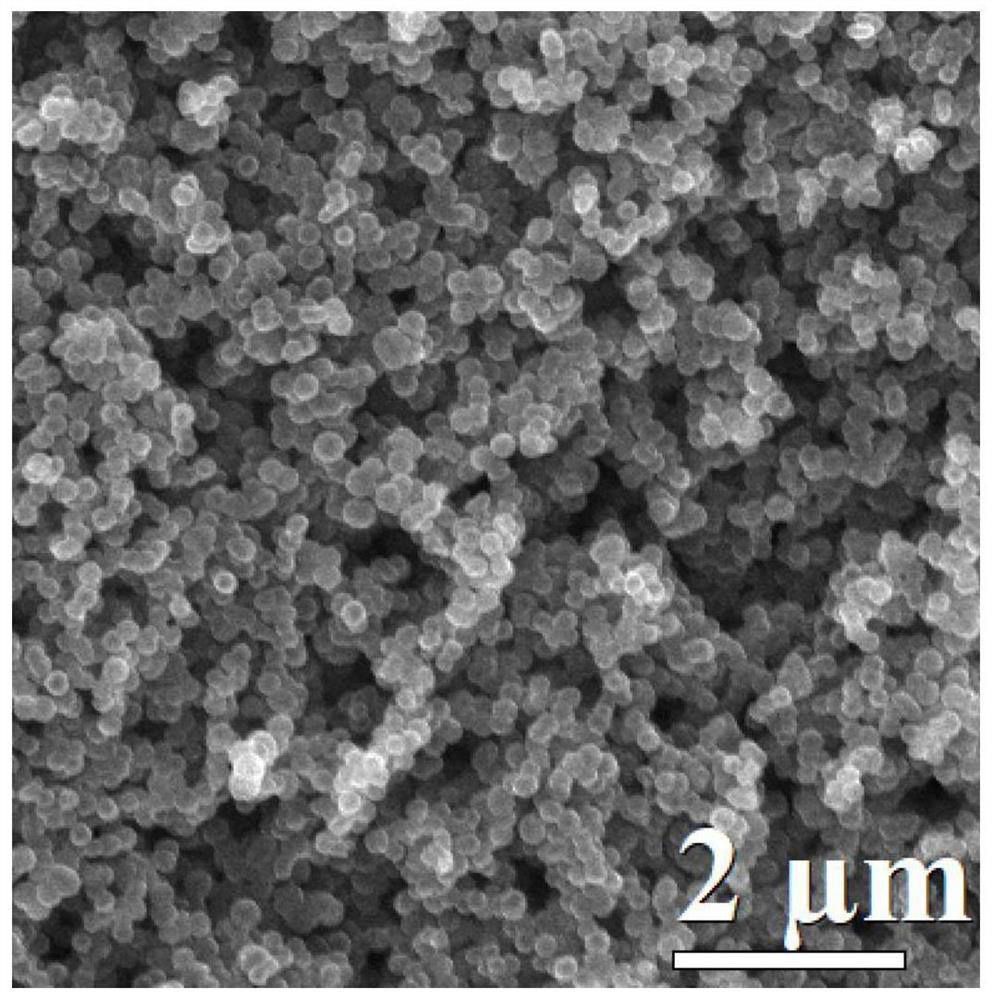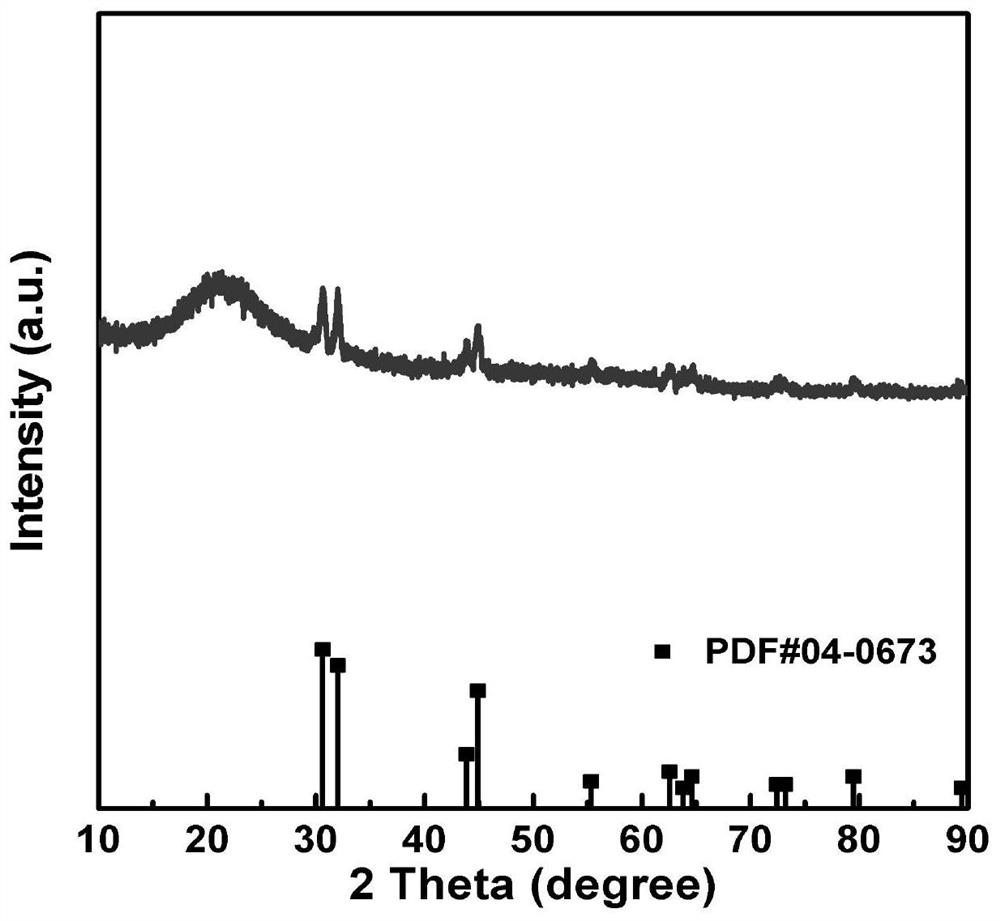Preparation method and application of hollow carbon nanosphere confinement tin nanocluster composite material
A carbon nanosphere and composite material technology, applied in the field of new materials, can solve the problems of cumbersome template removal steps, reduce atom economy, increase preparation steps, etc., achieve good sodium storage performance, and the supported nano-tin particles are environmentally friendly and broad. The effect of the application foreground
- Summary
- Abstract
- Description
- Claims
- Application Information
AI Technical Summary
Problems solved by technology
Method used
Image
Examples
Embodiment 1
[0030] A method for preparing a hollow carbon nanosphere confined tin nanocluster composite material, comprising the following steps:
[0031] S1, using the sol-gel method, take 0.9g of stannous chloride dihydrate and 0.3g of thiourea and disperse them in 30mL of ultrapure water, and magnetically stir until clarified to obtain a tin dioxide sol;
[0032] S2, take 2.5mL of tin dioxide sol and 51.5mL of ultrapure water into the reactor, add 6mL of TritonX-100 aqueous solution with a mass concentration of 0.01g / mL, 0.38mL of pyrrole monomer and 0.49mL of aniline monomer, and stir by magnetic force , ultrasonic dispersion, and stirring in an ice-water bath for 30 minutes each, add pre-cooled ammonium persulfate solution, stand at 0°C for polymerization reaction for 10 hours, collect the product by vacuum filtration, and wash the product with ultrapure water until the pH of the filtrate is close to neutral. properties, and then dried in a 60°C drying oven to obtain a hollow carbon-...
Embodiment 2
[0038] A method for preparing a hollow carbon nanosphere confined tin nanocluster composite material, comprising the following steps:
[0039] S1. Using the sol-gel method, disperse 0.9g of stannous chloride dihydrate and 0.3g of thiourea in 30mL of ultrapure water, and magnetically stir until clear to obtain a tin dioxide sol.
[0040] S2, take 2.5mL of tin dioxide sol and 51.5mL of ultrapure water into the reactor, add 6mL of TritonX-100 aqueous solution with a mass concentration of 0.01g / mL, 0.29mL of pyrrole monomer and 0.38mL of aniline monomer, and stir by magnetic force , ultrasonic dispersion, and stirring in an ice-water bath for 30 minutes, add pre-cooled ammonium persulfate solution, and stand at 0°C for polymerization reaction for 10 hours. After the reaction, collect the product by vacuum filtration, and wash the product with ultrapure water to the filtrate The pH is close to neutral, and then dried in a drying oven at 60°C to obtain a hollow carbon-confined tin p...
Embodiment 3
[0044] A method for preparing a hollow carbon nanosphere confined tin nanocluster composite material, comprising the following steps:
[0045] S1. Using the sol-gel method, disperse 0.9g of stannous chloride dihydrate and 0.3g of thiourea in 30mL of ultrapure water, and magnetically stir until clear to obtain a tin dioxide sol.
[0046] S2, take 5mL of tin dioxide sol and 49mL of ultrapure water into the reactor, add 6mL of TritonX-100 aqueous solution with a mass concentration of 0.01g / mL, 0.38mL of pyrrole monomer and 0.49mL of aniline monomer, magnetic stirring, ultrasonic After dispersing and stirring in an ice-water bath for 30 minutes, add pre-cooled ammonium persulfate solution, and stand at 0°C for polymerization reaction for 10 hours. After the reaction, collect the product by vacuum filtration, and wash the product with ultrapure water until the pH of the filtrate is close to Neutral, and then dried in a 60°C drying oven to obtain a hollow carbon-confined tin precurs...
PUM
| Property | Measurement | Unit |
|---|---|---|
| Diameter | aaaaa | aaaaa |
| Specific surface area | aaaaa | aaaaa |
| Total pore volume | aaaaa | aaaaa |
Abstract
Description
Claims
Application Information
 Login to View More
Login to View More - R&D
- Intellectual Property
- Life Sciences
- Materials
- Tech Scout
- Unparalleled Data Quality
- Higher Quality Content
- 60% Fewer Hallucinations
Browse by: Latest US Patents, China's latest patents, Technical Efficacy Thesaurus, Application Domain, Technology Topic, Popular Technical Reports.
© 2025 PatSnap. All rights reserved.Legal|Privacy policy|Modern Slavery Act Transparency Statement|Sitemap|About US| Contact US: help@patsnap.com



